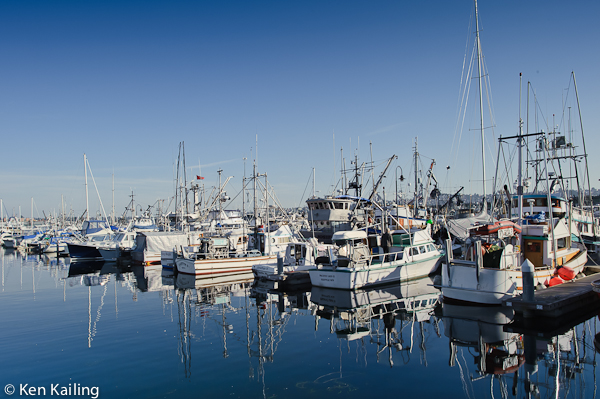
We are just beginning to understand that we may soon reach the end of the line – pun intended – for some of our “keystone” fish species: salmon, sea bass, cod and tuna. Authors Paul Greenberg (Four Fish) and Daniel Pauly (Five Easy Pieces) have written excellent books telling us how – and why – we will be out of fish by the middle of the century unless we take some drastic steps.
Top chefs in the US and Europe are pushing for sustainable seafood; “sustainable sushi” bars are popping up in cities across the country; and food service giants like Bon Appétit Management Company and Sodexo are offering sustainable seafood.
But how is a discerning consumer going to find good quality, sustainable fish to purchase for his or her own table?
GoodFood World has researched and tracked a particular brand of Coho (Silver) and Chinook (King) salmon from the boat to the supermarket. Caught and processed under very stringent controls, Bruce Gore Frozen-at-Sea® salmon meets – and exceeds – the requirements for sustainably harvested fish.
Taken in the waters off Sitka, Alaska, these fish meet the tough Alaskan sustainability regulations and the equally tough processing and preparation requirements from Triad Fisheries Ltd, marketer of Bruce Gore salmon.
Residents of Puget Sound are lucky enough to be able to shop at one of several Town and Country Markets, and buy “perfect fish” sourced by Chris King, Seafood Specialist.
Here’s the story from fisherman to retailer…
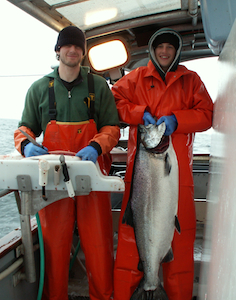
Even perfect fish don’t easily get from boat to table. Fishermen like Krist Martinsen, captain of the Fishing Vessel Constance, Sitka Alaska, take special care to treat the fish they catch respectfully and prepare them carefully.
Martinsen and his sons, Olin and Karl, are troll fishermen and fish with hooks and lines, using natural and artificial baits. They bring each fish in by hand.
When a fish is caught in a gill net or a seine it goes into stress as it starts to suffocate. That stress causes the fish to build up lactic acid in its muscles, just like humans do under stress. (Watch the video below to see how purse seined salmon are netted and moved to the hold of the boat by vacuum suction through giant tubes.)
The F/V Constance travels at 2-3 knots, the same speed that the fish are moving in the water. When the fish bites, the line is brought to the back of the boat slowly.
The fish is brought to the side of the boat and stunned to prevent it from flopping on the deck and bruising. Then a cut is made through the gills to drain the blood, the head is cut off, and the fish is eviscerated. In a time-consuming step, all remaining blood is removed under pressure. To ensure that no degradation takes place once it’s frozen, each fish must be bloodless when is placed in the freezer.
(To see exactly how this is done, watch this video. Warning: It’s not for the squeamish.)
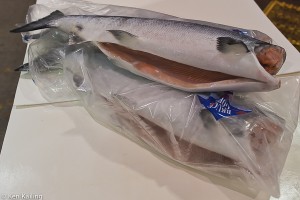
The final preparation for freezing requires that each fish be carefully arranged in the freezer with the belly open and the tail spread completely flat. Once frozen, the fish are dipped in salt water to create a glaze that prevents air from reaching the meat.
On deck – or below – each boat has a “super freezer” that rapidly drops the core temperature of the fish down to -30 degrees. Fish are prepared so fast that they are frozen “pre-rigor” and actually go through rigor mortis after they are thawed.
Mark Tupper, Triad Fisheries, offers these premium-priced specialty fish, considered sashimi-grade salmon, to customers around the world under the Bruce Gore Frozen-at-Sea brand.
About one-third of the fish goes to Europe, to distributors or wholesalers that sell to retailers and restaurants or to processors who are smoking the fish or making other products.
Another third goes to Japan; much of it to the Tsukiji Market which is a wholesale fish market in Tokyo where an old, established Japanese family sells to high-end retailers in the Tokyo area and to top-tier sushi restaurants.
The final third stays in the US going to wholesalers, retailers, restaurants, and food processors.
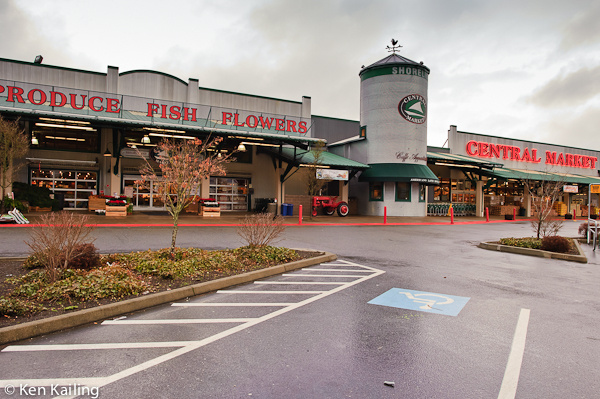
Town and Country Markets, which include three Central Markets, Greenwood Market, Ballard Market, and Bainbridge Island Town and Country Market, offer Bruce Gore Frozen-at-Sea salmon in their fish departments. GoodFood World took the opportunity to talk with Chris King, Seafood Specialist for Town and Country Markets; here’s what he had to say about sourcing sustainable seafood…
GoodFood World: Chris, would you fill us in on what a seafood specialist does?
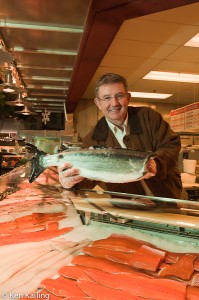
Chris King: You could call me a business unit manager for the seafood sales in our stores. I’m responsible for selection, quality control, and managing our products to reflect our core values.
We believe the fish should be caught and handled sustainably and with integrity; and we want to know where the seafood comes from. As part of our community, we are partners with our customers, our suppliers and our staff.
On the business end, I’m responsible for sales and gross profit projections. I manage the budgets for the seafood departments as part of the teams making decisions for what’s appropriate for each store.
At Town and Country Markets, we want to have the most sustainable products available and that means most of our seafood comes from Alaska. Fish like Bruce Gore Frozen-at-Sea also have a lower carbon footprint than “fresh” fish because it is not air freighted but delivered by barge.
GoodFood World: Do you have to go out and find new suppliers? Do you buy directly from the fisherman or through someone like Triad Fisheries?
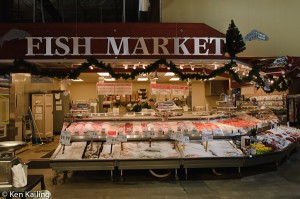
Chris King: Actually new suppliers come to me; I don’t have to go find them. We usually buy from a broker or distributor rather than directly from the boat. Mark Tupper at Triad is about as direct as it gets.
There is a great group catching salmon off the Aleutian Islands called the Aleutia Group, which sells both fresh and frozen salmon. But Mark’s boats out of Sitka Alaska have the best process out there; it is really untouchable when it comes to how you should handle fish.
The fish are so nearly perfect they look like they should be hung on the wall as a trophy. Volume fishing, which is a lot cheaper, is much harder on the fish.
My suppliers have to be able to meet my specs: 6+ pounds for Sockeye, Silver salmon (also called Coho) at 7-9 pounds and 9+ pounds, and 18+ pounds for King (also called Chinook) salmon. The larger the fish, the higher the fat content, and that means richer flavor.
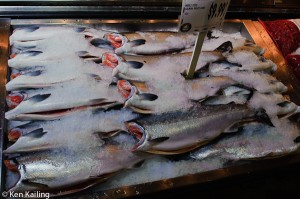
I also need to know how long the fish has been on the boat; the time from the water to my shop is the most important. I can get fish deliveries every day, but it doesn’t matter if the fish is two weeks old.
It’s hard to go wrong with fish out of Alaska, it’s probably the most sustainable, but it’s not the only kind of fish I buy.
GoodFood World: You carry Chilean Sea Bass – one of the types of fish that some of your customers may have expressed concern about.
Chris King: Yes, I have some beautiful Chilean Sea Bass from the Georgia Islands off Argentina, where the fishery is Marine Stewardship Council (MSC)-certified. The fishery uses modified long-lines that reduce by-catch of seabirds and follows a careful management plan to reduce overfishing.
GoodFood World: Do you seek out fish that is MSC-certified or listed as Monterey Bay Aquarium Seafood Watch “Best Choices” or “Good Alternatives”? How do you decide which fish is sustainable?
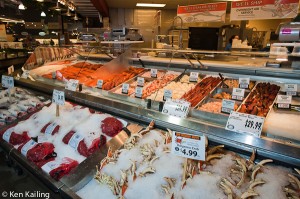
Chris King: We go to the source rather than depend on a marketing program like the Monterey Bay Seafood Watch or MSC. I look for science-based information, not labels and certifications.
We depend on the Smithsonian Institution, the National Fisheries Institute, and NOAA – National Oceanic and Atmospheric Administration – as some of our sources of information.
Information changes quickly in our industry so we have to make those connections ourselves. You need to take a stand and make the right decision for the moment, knowing that tomorrow it could change.
GoodFood World: As a seafood buyer, you have options to buy imported, farmed, and wild-caught fish; how do you make your choices? Do you travel to the source? For example, shrimp and prawns are available that are farmed in Indonesia; do you go there? How do you validate the information you’re given?
Chris King: The criteria I work from are pretty straightforward:
- The fish has to be good, healthy, and safe for our customers.
- It has to be as represented (what they say it is).
- There has to be a consistent supply.
- The fishery can’t harm the environment.
I don’t travel to inspect fisheries and farms, I have trusted relationships with vendors and representatives there; I don’t really need to go. We rely on their integrity and knowledge.
The Food and Drug Administration (FDA) inspects everything that comes in and the sellers have to provide proper documentation.
GoodFood World: It seems that people are becoming more concerned about the sources of their food. Are you customers buying more wild-caught as opposed to farmed fish? Is this a trend?
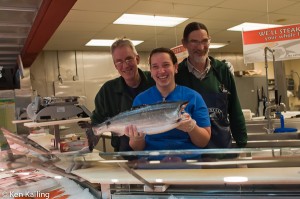
Chris King: Actually it seems these concerns are cyclical, and they never seem to get resolved. Our customers voice their opinions and vote with their dollars. We try to keep a variety of price points so our food is accessible to a wide range of customers.
Even though the economy has been down, we haven’t had to move to lower priced farmed salmon. Now that the economy has begun to turn around, we may find the price of wild-caught salmon going up, so there may be an opportunity for farmed salmon in the future.
That said, we need to ensure that farmed salmon don’t endanger the wild stock. I’m more concerned about farmed Atlantic salmon because they are more aggressive feeders if they get out into the wild.
GoodFood World: What about GMO salmon? The ones under testing right now are faster growing, eat more, and are physically larger and more mature than wild salmon at the same biological age.
Chris King: I don’t know enough about it yet. I don’t think that there is enough information out there. It’s not a route I’m going to take until I have more information.
Consumers Need to Know
We are just beginning to understand that we may soon reach the end of key fish stocks of the large predator fish – salmon, sea bass, cod and tuna – that we all love to eat. Unfortunately most consumers have no idea how the fish they eat really gets to the table.
The majority of fish available in conventional supermarkets – and on ice in some of the best natural food markets and co-ops – has been caught conventionally: by trawling, gillnetting, or purse seining. Net fishermen seek to catch as many fish as possible, as quickly as possible, and handle them as little as possible.
Contrast that to the careful and respectful handling Krist Martinsen and the captains of the other fishing vessels represented by Triad Fisheries give to the fish they catch.
Know where your fish comes from; ask your fish monger:
- Is this fish sustainably harvested?
- Do you know where this fish was caught?
- Do you know how this fish was caught?
- Do you know how this fish was handled after being caught?
- Is this fish “fresh” or “frozen at sea?”
The Tale of Two Salmon
Would you rather eat a salmon caught this way…
… or this way?
Editor’s Note/Full Disclosure: We purchased a pound of Bruce Gore Frozen-at-Sea Silver salmon and, as residents of Puget Sound where we are blessed with some of the best seafood in the world, we can attest to the superior quality and flavor of the fish. These fish meet our criteria for “Good Food:”
- It is Socially Responsible
- It maintains Environmental Resiliency
- It improves Economic Vitality

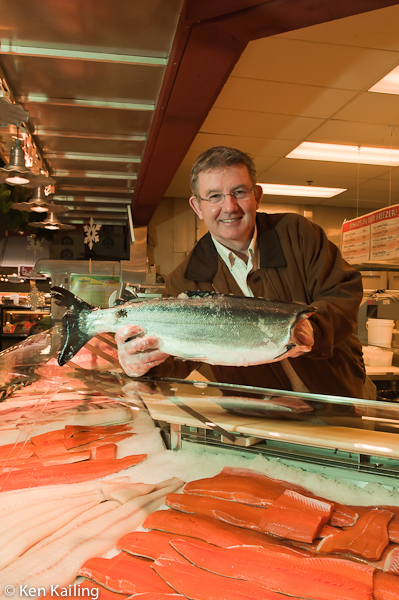
Gail & Chris,
One small correction. The Constamce was purchased by Krist Martinsen in 1995. It is true she was used. My husband had the boat built in 1979. Krist put a lof of time and skill into retrofitting her as a state-of the-art freezer troller. We bought a similarily sized boat with the same hold capacity but with a slightly larger wheelhouse. We wanted to have more room to start raising a family. Our daugher was 8-months-old when she started fishing in Alaska with us aboard the Saint Jude, the boat we currently own. Our son fished last year for 3 weeks. He is 8 and he loves fishing. Our story is typical of the families that troll for salmon on the West coast.
Both the F/V Constance and the F/V Saint Jude are 46′.
As to sustainability: to our family this simply means fishing in a responsible way that will preserve the resources for future generations. Our son and dughter deserve this as do our customers.
Chris, I wish you and your family all the best in your fishing endevours!
Karla Richardson
F/V Saint Jude
Greetings Chris; I just came across your note. All of our boats are family owned and run, the crew usually consists of a husband, wife and child, 3 people.
The length of our boats ranges from 38-48 feet. Each boat has spent money to install a very good freezer so the salmon can freeze to -30F or colder within a short time after its caught and cleaned.
We are not a high volume operation. We catch an average of 50 Coho a day and maybe 75 Kings if the weather is good and we find a school of salmon.
Our goal is take a perfect salmon from the ocean and deliver it to the customer without messing it up.
Mark,
It takes a whole team to get good food to consumers!
Keep up the great work!
Gail
Co-Publisher
GoodFood World
We are a fishing family in the East- while I can definitely see and agree with the benefits, there is a high cost to the boat- how big are the boats you are referring to in this article? Are they the last ones standing as a result of catch shares and have the big bag of money to afford freezing at-sea and other costly technologies that the small boats (44 foot)in the east see only as a pipedream.
What happened to all the small boat fishermen in Alaska? What happened to their families that tried to adhere to the new fishing regulations but couldn’t keep up with the costs? Did the big boats take them under their wing and give them all jobs?
We are all for fishing sustainably and want fish stocks to rebuild, but where is the partnership between sustainability in how we catch fish and sustainability of a fishing industry for future generations. The word sustainable is like the word local and organic- overused, misused,and means different things to different people.
I’m ready to hear both sides of the story instead of the stories of glory- because we all know there are just as many on the other side of things- inform the public of both and then let them make an educated decision as a FULLY informed consumer.
Chris,
Krist Martinsen is a small boat fisherman – it’s just him and his two sons on one boat. The boat he bought used 35 years ago, and rather than spend the money to retrofit it with a freezer below, he put it on the deck.
He has been dealing with the regulations and – while he told us sometimes they can be tough – those regulations are keeping the Alaska fisheries productive.
None of the 17 boats that sell salmon and lingcod through Triad Fisheries are working for “big boats,” they are all independent, family-owned boats.
Thanks so much for your input!
Gail N-K